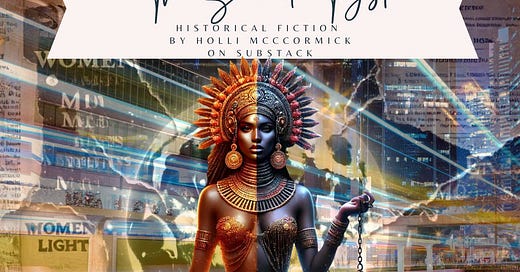THIS BEST-KEPT ANCIENT SCRIPTURE COULD BE THE UNRAVELING OF THE JUDEO-CHRISTIAN ACCOUNT OF CREATION
New York Times: Op-Ed Section (From "The Sacred Tryst" - historical fiction)
Dear Soul reader — here we are, the release of my first draft of The Sacred Tryst. This first part is the “prologue” to help readers (you!) understand the NEW CREATION story that kicks off this book - GENETRIX. A writing club friend suggested this…and I think as you read along, you will understand why. Op-Ed articles will start each Act in Book 1, and allow me to weave in some of the “REAL” history (if you’ve been watching Ep 5, you know why that is in quotes) that readers will need to know. Here….we….GO! Enjoy.
PART 1
Genetrix — The Ancestress
“When an event is too dangerous to be discussed, it is formed inside a myth and told as a story.”
~ Denis De Rougemont (Author), Montgomery Belgion (Translator)
New York Times: Op-Ed Section
THIS BEST-KEPT ANCIENT SCRIPTURE COULD BE THE UNRAVELING OF THE JUDEO-CHRISTIAN ACCOUNT OF CREATION
November 5, 2024
Author: Anonymous
NYT Editorial Note: We received this as a hand-written article with no return mailing address on January 6th, 2024. While the author of this article is anonymous, the editorial staff has gone to great lengths to fact-check this piece independently. The results of this thorough and time-consuming independent study show enough credible evidence to support the Genetrix scripture as an actual piece with in historical scholars’ hands. However, due to the scholars’ reluctance to say more than what is in this article, we felt placing it here in the Op-Ed section was the best place for it. The author sent us three letters and three chapters with the note we are to publish these separately. As of this time, we have received nothing more. Please continue to check back in with us here for the remainder of the articles, and any further breaks in this case.
********************************************
On Friday, April 6, 2012 — the Jewish date for Passover that year — in Eridu— an Ancient Sumerian city traditionally considered the original town of Mesopotamia — a first centruy CE papyrus scroll was found that has completely confounded Biblical Historical scholars, archeologists and epigraphists. Scholars date this scroll to circa 50 CE. It was found buried deep in a cave within earthen clay vessels, much like the Nag Hamadi Library and Dead Sea Scrolls1 so at first they thought perhaps this could have been a copy-cat type of situation. That is, until they saw it was written in Latin and estimated the date (more on this below). The cave is believed to have been a ritual cave of the Ancient Sumerian Goddess — Inanna (interestingly the key name in this text). This new piece of history leads scholars to believe this cave was where Sumerian patrons of Inanna re-enacted the rites mentioned in the script.
What plagues scholars are the following:
1. The prologue speaks of “the men of Israel” and the mannerism of writing is reminiscent of Genesis from the Hebrew Torah and Christian Old Testament.
This places the story as being from Ancient Israel, not the Babylon area of those times where it was discovered.
2. The story of Inanna was not circulating in these areas (Mesopotamia nor Israel) at this time (circa 50 CE). Her story and worship date from circa 4000-3100 BCE to circa 2340-2200 BCE.
At that time, termed the “Old Akkadian Period” (2340-2200 BCE), Inanna merges with Ishtar in the Akkadian (Akkadians were the Babylonians) and Assyrian Pantheons.
Eventually, this goddess made Her way into the region of Judea and Judaism as Asherah.
Yet, in the second chapter — to be shared at a later date — Inanna’s name is used.
3. There has been speculation that Asherah was the consort of Yahweh, the god of the Torah (Jewish Scriptures), and the Old Testament of the Christian Bible. Her cults were heavily disavowed and warned against.
Yet, this scripture points to Inanna being married to Tammuz — a name found in the Torah and Christian Old Testament, instead of his Sumerian name Dumuzi*.
* Inanna’s story was found in the 19th and 20th century, “Decent of Inanna into the Underworld,” and translated by epigraphists to the known stories we have today.
4. The Classical Latin used matches the dating and in part, how scholars are dating this peculiar find. Classical Latin was used, especially for writing, in the Roman Empire broadly from the 1st century BC to the early 1st century CE. The dominant languages of the area of Mesopotamia where this was found, an area that was not part of the Roman Empire in 50 CE, were mainly Parthian along with Aramaic and Greek.
Furthermore, Classical Latin was the language of the upper class and elite. However, the scholars have found a few key mistakes that allude to the writer not being of the elite or upper class, yet most likely place the author of Hebrew descent.
5. The three Sacred Rites shared in the second chapter blend known customs and sacred rituals from, at the very least, three to four distinct eras — across ancient borders, times, and cultures.
Keep reading with a 7-day free trial
Subscribe to Deconstructing Patriarchy to keep reading this post and get 7 days of free access to the full post archives.




